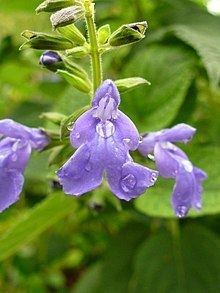Genus Salvia Rank Species | ||
 | ||
Similar Salvia holwayi, Salvia cacaliifolia, Salvia arizonica, Salvia corrugata, Salvia sinaloensis | ||
Salvia urica is a herbaceous perennial native to the mountains of Guatemala, Honduras, Belize, and Chiapas, Mexico. It is reportedly most common in Guatemala, where it grows in a wide variety of habitats from 1,000 to 8,000 feet (300 to 2,440 m) elevation, in a mild and moist climate. The specific epithet, urica, means "caterpillar" or "cankerworm", possibly describing the tight whorls of flowers, calyces, and bracts before they open.
Salvia urica grows up to 4 feet (1.2 m) in height and width, with the stems, leaves, and calyces all covered in long white hairs. Glands on the soft-textured leaves give off a slight pleasant aroma when brushed. The leaves are deltoid and 2 to 6 inches (5.1 to 15.2 cm) long, with slightly saw-toothed edges. The rich blue-violet flowers are .5 inches (1.3 cm) long, with 3-6 in each whorl, and held by green calyces. The flower's upper lip is narrow with short hairs, while the lower lip is wider with white markings.
